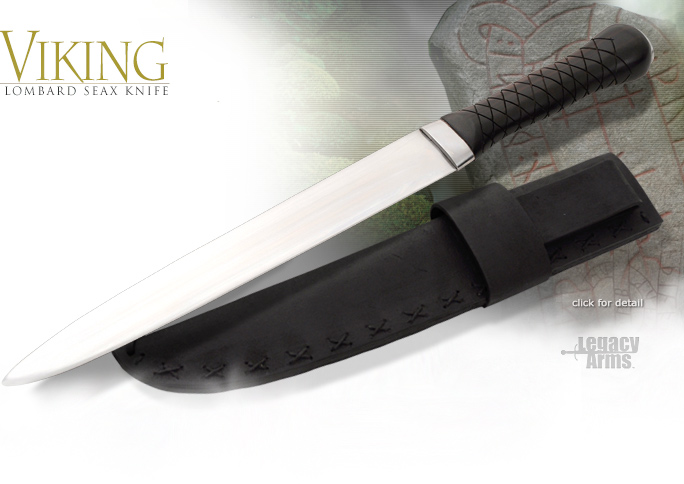LOMBARD SAXON SEAX IP-131 LEGACY ARMS IP-131 LEGACY ARMS
The Generation2/Legacy Arms Lombard Saxon Seax is based off a 6th century Anglo-Saxon version. The blade is made of 5160 tempered high carbon steel and measures over 12 inches long with a factory sharpened edge. This massive Viking knife is full tang construction and the tang is peened over top the steel end cap of the handle. The handle is of dark wood and the grip is beautifully carved in cross hatch design. The handle features a solid steel guard and end cap, and the full tan blade end is peened over the metal end cap at the pommel. Included is a hand cross-stiched brown leather scabbard which can hold the knife in an authentic traditional style or can be hung vertical. As with all Gen 2/Legacy Arms swords and daggers the Lombard Saxon Seax has a peened pommel and is hand forged with artisan's detail and care just like the originals. The IP-131 Lombard Seax is a prize for any Viking Saxon warrior who's on the row or on the go!

Read more on Functional Battle Ready Blades
|
|

• Overall length: 19-1/8"
• Blade length: 12-1/2"
• Grip Length: 6"
• Weight: 1 lb. 2 oz.
• Edge: Sharp
• Point of Balance: 1-3/8"
• Blade Steel: 5160 high-carbon steel
• Blade Width: 44.1 mm
• Blade Thickness: 4.5 mm - 3.7 mm
• Pommel: Peened

Specs may vary slightly from piece to piece.
|
A scramseax (also seax ) was a type of Germanic single-edged knife. Scramseax seem to have been used for warfare and as a tool. They occur in a size range from 2.9" to 29.5". The larger ones (langseax) were probably weapons, the smaller ones (hadseax) tools, intermediate sized ones serving a dual purpose. Wearing a scramseax may have been indicative of freemanship. The scramseax was worn in a horizontal sheath at the front of the belt. Scram refers to food and seax to a blade (so, "food knife"). There is some debate about the authenticity of the longer word scramseax. The Saxons may have derived their name from seax (the implement for which they were known) in much the same way that the Franks were named for their francisca. This claim is largely supported by the appearance of scramaseaxes in early Saxon heraldry.
|
|
|